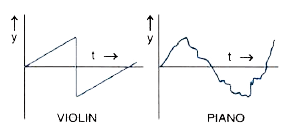How can you understand pitch and frequency in relation to working of musical instruments.
To understand the relationship between pitch and frequency in the context of musical instruments, we can break it down into several steps:
1. Definition of Frequency:
- Frequency is defined as the number of oscillations or cycles that occur in a sound wave per second. It is measured in Hertz (Hz), where 1 Hz equals 1 cycle per second.
2. Understanding Pitch:
- Pitch is the perceptual attribute of sound that allows us to classify it as high or low. It is directly related to the frequency of the sound wave; higher frequencies correspond to higher pitches, and lower frequencies correspond to lower pitches.
3. Pressure-Time Graphs:
- When we look at pressure-time graphs of sound waves, we can see that a high-frequency wave has more oscillations in a given time period compared to a low-frequency wave. This visual representation helps us understand how frequency affects pitch.
4. Relationship Between Frequency and Pitch:
- The relationship is straightforward: as the frequency increases, the pitch of the sound becomes higher. Conversely, as the frequency decreases, the pitch becomes lower. For example, a sound wave with a frequency of 512 Hz will have a higher pitch than a sound wave with a frequency of 256 Hz.
5. Characteristics of Sound:
- Besides pitch, sound has other characteristics such as loudness (the degree of sensation produced on the ear) and amplitude (the maximum height of the wave). Loudness is measured in decibels (dB).
6. Vibrations in a Medium:
- Sound travels through a medium (like air) by causing the particles of the medium to vibrate. Each particle vibrates at the same frequency as the sound wave, transmitting the sound through the medium.
7. Musical Intervals:
- Musical notes can be combined to create intervals. For instance, two sounds with a frequency ratio of 2:1 are separated by an octave, which is perceived as a pleasant sensation when heard together. Other intervals, such as a third or a fifth, have specific frequency ratios (like 5:4 and 3:2, respectively).
8. Conclusion:
- In summary, pitch and frequency are closely related concepts in sound. Understanding this relationship is crucial for the functioning of musical instruments, as different instruments produce different frequencies that correspond to specific pitches.
- Frequency is defined as the number of oscillations or cycles that occur in a sound wave per second. It is measured in Hertz (Hz), where 1 Hz equals 1 cycle per second.
- Pitch is the perceptual attribute of sound that allows us to classify it as high or low. It is directly related to the frequency of the sound wave; higher frequencies correspond to higher pitches, and lower frequencies correspond to lower pitches.
- When we look at pressure-time graphs of sound waves, we can see that a high-frequency wave has more oscillations in a given time period compared to a low-frequency wave. This visual representation helps us understand how frequency affects pitch.
- The relationship is straightforward: as the frequency increases, the pitch of the sound becomes higher. Conversely, as the frequency decreases, the pitch becomes lower. For example, a sound wave with a frequency of 512 Hz will have a higher pitch than a sound wave with a frequency of 256 Hz.
- Besides pitch, sound has other characteristics such as loudness (the degree of sensation produced on the ear) and amplitude (the maximum height of the wave). Loudness is measured in decibels (dB).
- Sound travels through a medium (like air) by causing the particles of the medium to vibrate. Each particle vibrates at the same frequency as the sound wave, transmitting the sound through the medium.
- Musical notes can be combined to create intervals. For instance, two sounds with a frequency ratio of 2:1 are separated by an octave, which is perceived as a pleasant sensation when heard together. Other intervals, such as a third or a fifth, have specific frequency ratios (like 5:4 and 3:2, respectively).
- In summary, pitch and frequency are closely related concepts in sound. Understanding this relationship is crucial for the functioning of musical instruments, as different instruments produce different frequencies that correspond to specific pitches.
Topper's Solved these Questions
- BOOK - ICSECHAPTER - SOUNDEXERCISE - Questions (Choose the correct option to fill in the blank)5videos
SOUND
- BOOK - ICSECHAPTER - SOUNDEXERCISE - Questions (Write T for True and F for False. Correct the false statements)5videos
SOUND
- BOOK - ICSECHAPTER - SOUNDEXERCISE - EXERCISE (STUDY QUESTIONS)20videos
SOUND
- BOOK - ICSECHAPTER - PHYSICAL QUANTITIES AND MEASUREMENT EXERCISE - Picture Study3videos
PHYSICAL QUANTITIES AND MEASUREMENT
- BOOK - ICSECHAPTER - WORK AND ENERGYEXERCISE - Picture Study3videos
WORK AND ENERGY
Similar Questions
How can you relate pitch and frequency?
View SolutionHow can you obtain lamp black?
View SolutionHow can you obtain lampblack?
View SolutionHow is pitch related to frequency?
View SolutionWhat do you understand by a Galvanic cell ? Explain the working of one such cell in detail.
View SolutionHow can you decrease the average density of an object?
View SolutionWhat do you understand by oxidation number? Mention the working rules used to calculate it.
View SolutionHow do you change the pitch of a wind instrument?
View SolutionTwo musical notes of the same pitch and same loudness are played on two different instruments. Their wave patterns are shown in Fig.

Explain why are the wave patterns different.View SolutionWhat do you understand by standard enthalpy of a reaction and how is it represented ?
View Solution

